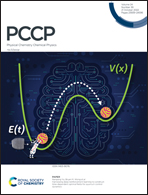Characterization of the charge transfer luminescence of the [WO6]6− octahedron in Ca3WO6 and the [WO5]4− square pyramid in Ca3WO5Cl2†
Abstract
Charge transfer (CT) luminescence of different types of polyhedra, [WO5]4− in Ca3WO5Cl2 and [WO6]6− in Ca3WO6, is characterized by spectroscopic experiments and ab initio calculations. According to the geometry optimization, W6+ ions form five-fold [WO5]4− square pyramids in Ca3WO5Cl2 because of a large interatomic distance between W6+ and Cl− of 3.266 Å. The analysis of the density of electronic states reveals the ionic character of Cl− ions to the W6+ ions in the Ca3WO5Cl2 lattice, resulting in the observed broad luminescence band peak at 488 nm of the single-crystal Ca3WO5Cl2 sample being assigned to the CT transition in the [WO5]4− square pyramid. Compared with the [WO6]6− octahedron in Ca3WO6, the [WO5]4− square pyramid shows an inconsistent CT energy shift: higher CT absorption and lower luminescence energies. The larger bandgap brings about higher absorption energy due to the structural and compositional features of the orthorhombic Ca3WO5Cl2. The redshifted CT luminescence band and small activation energy for the thermal quenching of the Ca3WO5Cl2 sample are explained, assuming that the CT states of the anisotropic [WO5]4− square pyramid take a larger offset in the configurational coordinate diagram than the [WO6]6− octahedron.
![Graphical abstract: Characterization of the charge transfer luminescence of the [WO6]6− octahedron in Ca3WO6 and the [WO5]4− square pyramid in Ca3WO5Cl2](/en/Image/Get?imageInfo.ImageType=GA&imageInfo.ImageIdentifier.ManuscriptID=D2CP02753D&imageInfo.ImageIdentifier.Year=2022)


 Please wait while we load your content...
Please wait while we load your content...